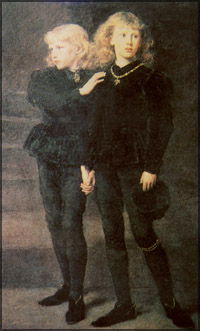|
Princes in the Tower:
Tracing their bloodline
Gwen Herat
PLAY: Some European scientists are poised to DNA test the skeletal
remains found under the staircase of the tower that were later removed
by Charles 1 and reburied at the Westminster Abbey.
They will determine whether they are the remains of the sons of
George, Duke of Clarence, brother of King Richard III and who was bound
to the Tower of London under arrest after the civil war after which King
Edward IV seized the throne from Henry VI. Richard ordered the pitiful
murder of his two innocent young nephews in tyrannical usurpation.
Between the time of the royal order on the execution, many incidents
could have occurred as some
|

FEATURES: The famous painting of the Princes in the tower by Millais
from Richard III, one of Shakespeare’s pathetic histories, clearly
show the semblance of Elizabethan features of Princes William and
Harry on their faces and tawny hair.
|
researchers argue that the two princes could have been smuggled
out and the bodies of two young boys who had died of the prevailing
plague, were placed under the stairway probably by Lord Buckingham who
did not have the conscience to carry out the order.
It was Tyrrell who murdered the princes in the Tower but he was
shaken by the experience that he left the two hardened murders to wipe
his tears at the trauma of killing the innocence.
The boy princes who appear in Richard III, makes a strong impact in
the play though they appear briefly. The play displays the dependents of
King Edward III who fought for the throne and who in the process created
the Houses of York and Lancaster.
Before Shakespeare wrote Richard II, he had already sketched out
Richard III in order to set the field for two more plays, King Henry IV
(part 1) and King Henry (part) to continue historical authenticity.
Henry Bolingbroke of the House of Lancashire seizes the throne from
young king Richard who is killed at Ponterfract Castle.
Shakespeare wrote ten historical plays with Richard III being one of
the foremost that shook England by its carnage. Richard was a grotesque
looking, with evil eyes and deformed leader who never allowed these
qualities to pull him back as he went on a carnage during his short
two-year reign, murdering all those who posed a threat to his kingdom
that included the young princes who disappeared from the tower.
It was also rumoured that he had poisoned his wife, Lady Anne because
she lost her son before her death and that Richard was mad about. But
there is no historical evidence to this myth.
When creating the stage for Richard III, Shakespeare had much of his
homework done from the chronicles of his time and history and believed
he was near accurate. But Shakespeare was more concerned in creating a
fast-moving drama in Richard II and III and hence depended on powerful
characters to trap the intensity of the play.
Thus the Princes in the Tower, though minute in their contribution to
the play’s progress, stand out on equal terms as of their infamous
uncle, Richard.
Richard was born in 1452 and died in 1485 at Bosworth. He had to
fight for his throne, confronted by Richmond after he had captured
Buckingham who is executed. With confidence he marches on only to fall
at the mercy of Richmond who believes that God is helping him to
overcome this ‘monster’.
The previous night Richard dreams of ghosts of his victims who appear
one by one. There is Henry VI and his son, Edward; Clarence, Rivers,
Grey and Vaughan, Hastings, Princes Edward and Richard, wife Anne, and
Buckingham.
If the DNA tests being carried out by the scientists to determine the
bloodline of the skeletal remains in the London Tower which Charles I
was subsequently entombed at the Westminister Abbey, does not belong to
the princes in question, they will have to assert as to where the
princes were and sample the DNA of Elizabeth I to their surviving
bloodline.
Whether it ended with the current Queen Elizabeth II of England who
ends the Hanoverian House that has branched down from the Houses of York
and Lancashire. When Charles ascends the throne after Elizabeth, it will
be from the House of Windsor and followed by Prince William, second in
line.
My presumption based on my own theories and after studying the faces
of the princes in the tower, their bloodline after being traced, will
finally sit on Princes William and Harry.
So, the secret is in the bones at Westminster Abbey. |

